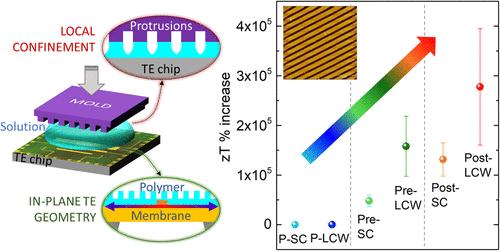Enhancing zT in Organic Thermoelectric Materials through Nanoscale Local Control Crystallization
IF 16
1区 材料科学
Q1 CHEMISTRY, MULTIDISCIPLINARY
引用次数: 0
Abstract
Organic thermoelectric materials are promising for wearable heating and cooling devices, as well as near-room-temperature energy generation, due to their nontoxicity, abundance, low cost, and flexibility. However, their primary challenge preventing widespread use is their reduced figure of merit (zT) caused by low electrical conductivity. This study presents a method to enhance the thermoelectric performance of solution-processable organic materials through confined crystallization using the lithographically controlled wetting (LCW) technique. Using PEDOT as a benchmark, we demonstrate that controlled crystallization at the nanoscale improves electrical conductivity by optimizing chain packing and grain morphology. Structural characterizations reveal the formation of a highly compact PEDOT arrangement, achieved through a combination of confined crystallization and DMSO post-treatment, leading to a 4-fold increase in the power factor compared to spin-coated films. This approach also reduces the thermal conductivity dependence on electrical conductivity, improving the zT by up to 260%. The LCW technique, compatible with large-area and flexible substrates, offers a simple, green, and low-cost method to boost the performance of organic thermoelectrics, advancing the potential for sustainable energy solutions and advanced organic electronic devices.

通过纳米级局部控制结晶提高有机热电材料的 zT
有机热电材料因其无毒性、丰富性、低成本和灵活性,在可穿戴加热和冷却设备以及近室温发电方面大有可为。然而,由于导电率低,它们的优点系数(zT)降低,这是阻碍其广泛应用的主要挑战。本研究介绍了一种利用光刻控制润湿(LCW)技术,通过限制结晶提高可溶液加工有机材料热电性能的方法。以 PEDOT 为基准,我们证明了纳米尺度的受控结晶可通过优化链包装和晶粒形态提高导电性。结构特性分析表明,通过限制结晶和 DMSO 后处理的结合,形成了高度紧凑的 PEDOT 排列,与旋涂薄膜相比,功率因数提高了 4 倍。这种方法还降低了热导率对电导率的依赖性,将 zT 提高了 260%。LCW 技术与大面积和柔性基底兼容,提供了一种简单、绿色和低成本的方法来提高有机热电的性能,推动了可持续能源解决方案和先进有机电子设备的发展潜力。
本文章由计算机程序翻译,如有差异,请以英文原文为准。
求助全文
约1分钟内获得全文
求助全文
来源期刊

ACS Nano
工程技术-材料科学:综合
CiteScore
26.00
自引率
4.10%
发文量
1627
审稿时长
1.7 months
期刊介绍:
ACS Nano, published monthly, serves as an international forum for comprehensive articles on nanoscience and nanotechnology research at the intersections of chemistry, biology, materials science, physics, and engineering. The journal fosters communication among scientists in these communities, facilitating collaboration, new research opportunities, and advancements through discoveries. ACS Nano covers synthesis, assembly, characterization, theory, and simulation of nanostructures, nanobiotechnology, nanofabrication, methods and tools for nanoscience and nanotechnology, and self- and directed-assembly. Alongside original research articles, it offers thorough reviews, perspectives on cutting-edge research, and discussions envisioning the future of nanoscience and nanotechnology.
 求助内容:
求助内容: 应助结果提醒方式:
应助结果提醒方式:


